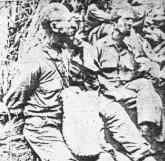Page 8
The next morning the Japanese continued separating the men into
groups of 300. Finally the decision to move the prisoners was made.
They were to be moved north to Balanga. No provisions for transportation
had been made. The prisoners were to walk. Neither were there
plans made to feed the prisoners until they reached their destination.
Then two columns were formed. POWs on the left and civilians
on the right, with Jap guards strutting up and down the middle.
Throughout the morning, dozens of Japanese tank commanders and hundreds
of cavalrymen attempted to organize the march.  By
noon, it had been twenty-four hours since the men had received food or
water. Suffering from heat exhaustion, they began to fall like flies.
Any man who could not stand on his feet was promptly bayoneted. By
noon, it had been twenty-four hours since the men had received food or
water. Suffering from heat exhaustion, they began to fall like flies.
Any man who could not stand on his feet was promptly bayoneted.
It was apparent that the Japanese had no intention of following
either the Hague or the Geneva conventions governing the POW’s.
The columns moved north out of Mariveles toward little Baguio.
Unsure of their destination and knowing many would not survive, the prisoners
marched. Japanese planes, keeping constant surveillance on
the march, flew back and forth over the lines.
All along the road were abandoned packs, helmets, blankets
and canteens littering the ditches. The further they marched the
more the castoffs increased.
Occasionally, they would pass a naked corpse, the face
swollen and covered with maggots. The body stiff and beginning to blacken
in the intense heat, already covered with flies as carrion birds
tore at the flesh.
To amuse themselves, the Japanese guards would push  prisoners
over cliffs. Their screams ended only when they hit jagged rocks
below. The Filipinos fared even worse. Young girls were pulled out of ranks
and raped repeatedly. Anyone who resisted was shot. Frightened mothers
would rub human dung on their daughters' faces to make them unattractive
to the guards. prisoners
over cliffs. Their screams ended only when they hit jagged rocks
below. The Filipinos fared even worse. Young girls were pulled out of ranks
and raped repeatedly. Anyone who resisted was shot. Frightened mothers
would rub human dung on their daughters' faces to make them unattractive
to the guards.
Conditions continued to deteriorate. "Speedo! Speedo!" yelled the guards
and trotting began at double time up the steep slope. Men dropped everywhere
and were quickly bayoneted. Anyone who tried to help them was shot.
All semblance of order ceased. The prisoners stumbled over their
own comrades. Filipino women and children suffering from starvation,
dysentery and exhaustion, fell to the ground.
Night settled slowly but still they marched. The blistering sun
had disappeared but the gnawing hunger and searing thirst remained. Then
another tormentor, the malaria-carrying mosquito began to bite on their
exposed bodies.
As morning came, along side the road they could hear cooling springs
but if they tried to reach one they were killed. Some of the prisoners,
suffering from cerebral malaria, went insane. Waves of heat rose
from the road. Big tractors pulling 250 millimeter guns toward the
bay for the continuing attack on Corregidor, rolled over the bodies
of the dead and dying along the road.
|